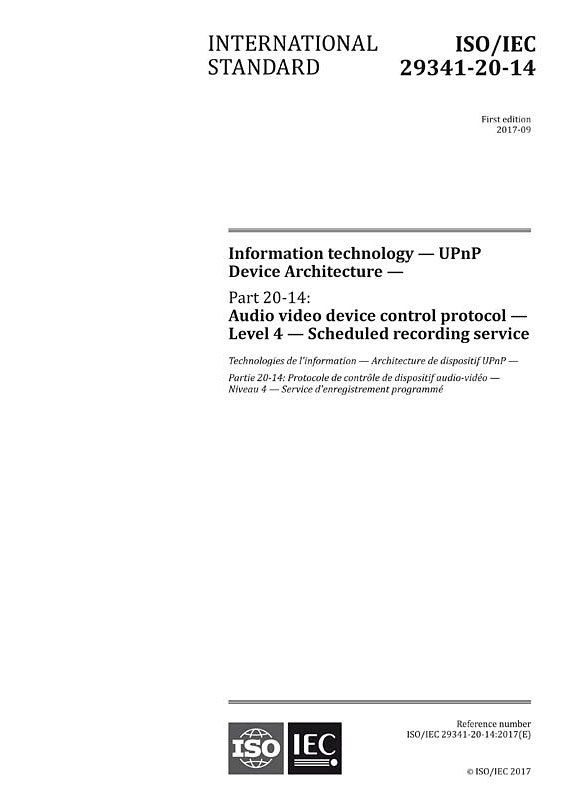ISO/IEC 29341-20-14:2017 is compliant with the UPnP Device Architecture version 1.0 [14]. It defines a service type referred to herein as ScheduledRecording service.
The ScheduledRecording service is a UPnP service that allows control points to schedule the recording of content. Generally, this content is broadcast content, but this specification does not limit itself to broadcast content. This service type enables the following functions:
- Create a recordSchedule so that it is added to the list of recordSchedule instances. Each recordSchedule describes user-level recording instructions for the ScheduledRecording service.
- Browse a list of recordSchedule instances stored by the ScheduledRecording service.
- Delete a recordSchedule so that it is removed from the list of recordSchedule instances.
- Browse a list of recordTask instances, stored by the ScheduledRecording service. The ScheduledRecording service may create zero or more recordTask instances for each recordSchedule. A recordTask represents a discrete recording operation of a recordSchedule.
- Enable or disable individual recordTask instances.
- Enable or disable a recordSchedule.
- Receive notifications i ndicating change of recordSchedule or recordTask list.
The ScheduledRecording service does not require a dependency on any UPnP services other than a co-located ContentDirectory service, which provides the following functions:
- A ContentDirectory service provides channel line-up to allow users to find recordable channels. A control point may use this metadata when creating a recordSchedule on a ScheduledRecording service.
- A ContentDirectory service may provide Electronic Program Guide (EPG) features to allow users to find recordable content. A control point may use this metadata when creating a recordSchedule on a ScheduledRecording service.
- Contents recorded by the ScheduledRecording service may be exposed by a ContentDirectory service.
The architectural relationship among the different concepts, defined by the ScheduledRecording service can be summarized as follows: A ScheduledRecording service owns a flat (that is: non-nested) list of recordSchedule instances, meaning that the ScheduledRecording service may create, destroy, or change recordSchedule instances. A recordSchedule represents user-level instructions to perform recording operations. Generally, a user constructs his instructions to a ScheduledRecording service via a control point that invokes UPnP actions that affect the list of recordSchedule instances. In all cases, the ScheduledRecording service shall be able to describe discrete recording operations for a recordSchedule through a list of associated recordTask instances. A recordTask can only exist with a recordSchedule (that is: never orphaned). Thus when a recordTask is created by the ScheduledRecording service, its lifetime depends on its parent recordSchedule. An individual recordTask can be selectively enabled or disabled.
This service template does not address:
Implementations where the ScheduledRecording service and its associated ContentDirectory service are not co-located in the same device.


